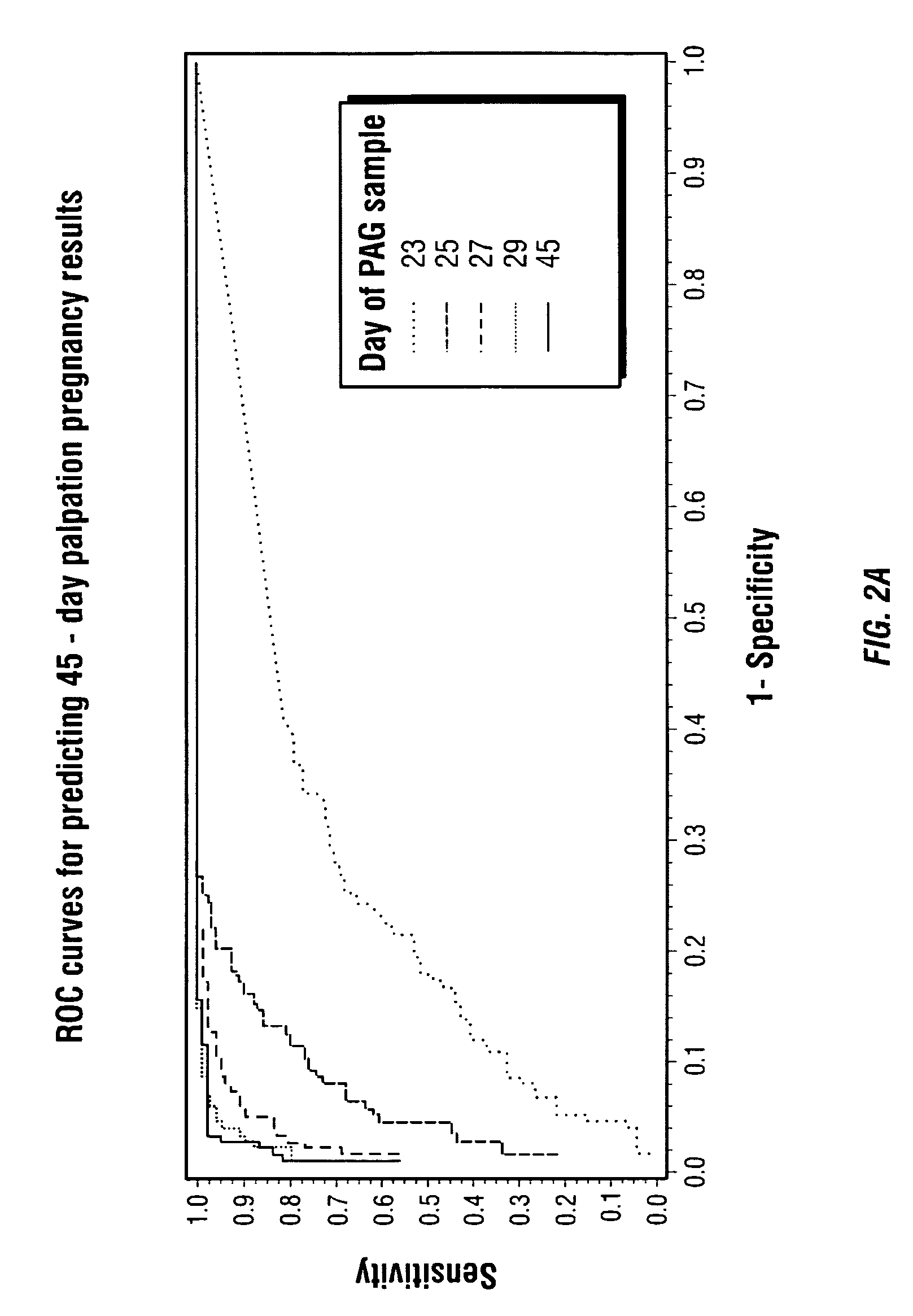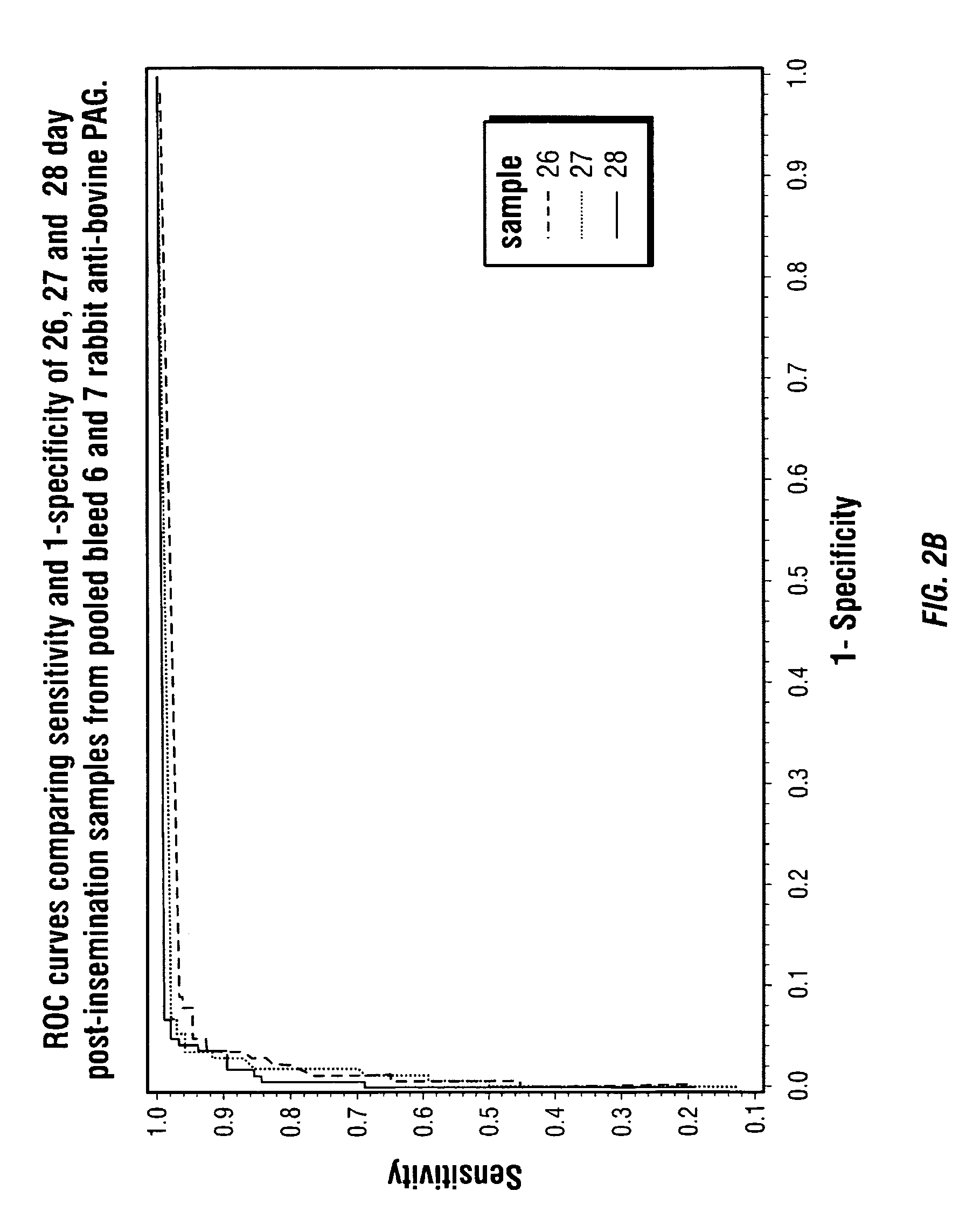Methods for early detection of pregnancy in cows
a technology for cows and milk, applied in the field of veterinary medicine, reproductive biology and diagnostics, can solve the problems of unacceptably high false positive rate of milk or serum progesterone measurement around day 18-22, and the possibility of a positive diagnosis in the fourth week of pregnancy remains somewhat uncertain,
- Summary
- Abstract
- Description
- Claims
- Application Information
AI Technical Summary
Benefits of technology
Problems solved by technology
Method used
Image
Examples
example 1
Isolation and Characterization of PAG-55 Enriched Protein Fraction
[0222]The following flowchart describes the purification of acidic PAG-55 fraction, enriched for early PAGs, isolated from day 55-60 bovine cotyledonary tissue (which is a descriptive term for the gross structure of the placenta and specifically the tufts of villous trophoblast (cotyledons) that insinuate themselves into the crypts of the maternal caruncles). Shown below are steps of the purification and various buffer compositions.
[0223]
[0224]Generally, the above purification process utilizes the pepstatin binding characteristic of PAGs. Based upon the pepstatin binding characteristics of PAGs at various different pH's, PAGs can be fractionated, or separated into three categories: neutral PAGs (PAGs binding to pepstatin at neutral pH), acidic PAGs (PAGs binding to pepstatin in acidic pH, and basic PAGs (PAGs binding to pepstatin in basic pH). The fraction most suitable for use in pregnancy tests of the present invent...
example 2
Generation of Polyclonal Antibodies Immunoreactive with PAG-55 Enriched Protein Fraction
[0252]10 rabbits were immunized with day 55-60 acidic PAG fraction by using standard immunization protocols (i.e. with an adjuvant). The monthly bleeds were checked for antibody titer and IgG purification. The purified IgG fraction from all 10 rabbits was used for developing the PAG-55 ELISA. A test panel of bovine plasma samples (37 pregnant and 24 open cows) from day 28 post insemination was used to determine the sensitivity (ability to detect pregnant cows) and specificity (ability to detect open cows) in a PAG-55 ELISA optimized with antibodies from each rabbit. The test panel results with IgG fraction from the 7th bleed for five rabbits are shown in Table 4.
[0253]
TABLE 4PAG-55 ELISA RESULTS#368#369#370#371#375Sensitivity (%)8910010010076.5Specificity (%)911001009686.5Cut-off (ng / ml)0.801.51.00.9
[0254]The Table 4 results show that rabbit IgGs from test samples #368, #369, #370, and #371 could...
example 3
Comparing Whole, Non-Clotted Blood to Non-Centrifuged, Clotted Blood for Use in PAG-Based Pregnancy Tests for Cows Using Lateral Flow Technology
[0256]Whole blood was collected from thirteen Holstein cows from the coccygeal vein. Blood was collected into either a 4 ml Vacutainer® (Becton Dickinson) serum separator tube (SST tube, containing at least one clot activator or a gel and clot activator), or into a 10 ml Vacutainer® plasma tube containing K3 EDTA. Plasma tubes were kept on ice while the serum separator tubes were maintained at room temperature. Clot activators include any agent that promotes clot formation including, but not limited to thrombin, phospholipids, kaolin (a clay material), micronized silica (e.g. polysiloxane), and calcium. Other factors that could be added to the collection tubes include platelet agonists, such as collagen or the thrombin receptor agonist peptide, SFLLRN, that would be expected to significantly accelerate the clotting of native whole blood and ...
PUM
| Property | Measurement | Unit |
|---|---|---|
| concentration | aaaaa | aaaaa |
| concentration | aaaaa | aaaaa |
| temperatures | aaaaa | aaaaa |
Abstract
Description
Claims
Application Information
 Login to View More
Login to View More - R&D
- Intellectual Property
- Life Sciences
- Materials
- Tech Scout
- Unparalleled Data Quality
- Higher Quality Content
- 60% Fewer Hallucinations
Browse by: Latest US Patents, China's latest patents, Technical Efficacy Thesaurus, Application Domain, Technology Topic, Popular Technical Reports.
© 2025 PatSnap. All rights reserved.Legal|Privacy policy|Modern Slavery Act Transparency Statement|Sitemap|About US| Contact US: help@patsnap.com



